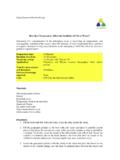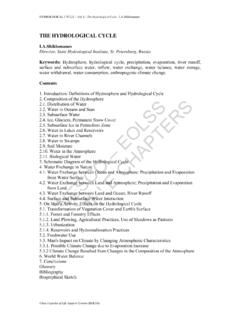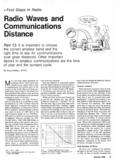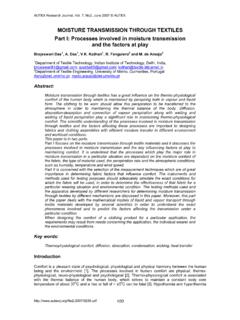Transcription of STAINLESS STEEL Surface Analysis - Material Interface, Inc
1 AES and XPS Analysis of the passivation layer on STAINLESS STEEL can help determine how well it willresist J. Kerber* Material Interface Inc. Sussex, WisconsinJohn Tverberg** Trent Tube Inc. East Troy, Wisconsin Auger electron spectroscopy (AES) and X-ray photoelectron spectroscopy (XPS)are valuable techniques for analyzingthe Surface of STAINLESS steels to establishtheir ability to resist corrosion. AES identifies theatoms in a layer by measuring the characteristicAuger electron energy, which is emitted in stepsfrom an inner atomic shell. XPS (also known asESCS, electron spectroscopy for chemical Analysis )measures the energy spectra of electrons emittedwhen the Surface is exposed to of these techniques have an Analysis depthof approximately 2 to 4 nm (20 to 40 angstroms, orabout ten atom layers); shallower measurementscan be made under specially designed experimentalconditions.
2 AES can have a very small Analysis di-ameter, down to 20 nm (200 angstroms), and its pri-mary function is to provide elemental identifica-tion. XPS has a larger diameter of Analysis (aboutten microns), and is mainly used to determine thechemical state of near- Surface elements. Both tech-niques can detect elements above atomic numbertwo, with a limit of approximately atomic per-cent. Standard AES and XPS instruments have theability to sputter argon ions to depth-profile thesurfaces of interest, yielding composition as a func-tion of depth. For STAINLESS STEEL Analysis , the totaldepth of Analysis is typically 15 and XPS data can be quantitatively analyzedby means of elemental sensitivity factors, normal-ization values that are based on yields for pure el-ements.
3 Because of these factors, Analysis of thesame Surface with AES and XPS can yield slightlydifferent quantified compositions. When precise*Member of ASM International**Life member of ASM Internationalquantification is required, standards similar to theunknown should be the article explains how AES and XPS analysisof STAINLESS STEEL surfaces treated by various chem-icals can provide valuable information about pas-sivation layer composition and depth, and its abilityto protect against corrosion. The Surface of STAINLESS steelAnalysis of clean metallic samples exposed tothe atmosphere typically shows levels of 10 to 20%carbon and 30 to 50% oxygen.
4 The carbon (com-monly called adventitious carbon) is present pri-marily because of adsorbed hydrocarbons andcarbon oxides; the oxygen is from instantaneousoxide formation, as well as adsorbed water vaporand carbon dioxide. A clean metallic Surface is veryreactive and adsorbs more water vapor and at-mospheric contaminants than a ceramic or a cont-aminated Surface . Figures 1 and 2 show AES andXPS survey scans of mechanically polished 316stainless STEEL that has been exposed to the atmos-phere. By definition, STAINLESS STEEL contains a minimumof 50% iron and chromium. Corrosion resis-tance is the result of protection conferred by achromium-rich passive layer, which is typically onthe order of 3 to 5 nm thick, or about 15 layers ofSTAINLESSSTEELS urface AnalysisStainless STEEL is rendered resistant to corrosion because of the development of achromium-rich chromium oxide passive layer on the Surface .
5 ADVANCED MATERIALS & PROCESSES/NOVEMBER 2000 33atoms. The passive layer is formed by an oxidation-reduction reaction in which the chromium and ironare oxidized, and the passivating agent is this layer is not allowed to form, or if the layer isbroken, rapid general and/or galvanic corrosioncan follow. The Surface chemistry of STAINLESS STEEL ultimatelydepends largely on the chemical or mechanical pro-cessing of the Surface . Studies show that air oxida-tion at most temperatures results in a two-layeroxide structure. The outermost layer ( -Fe2O3)forms before the inner iron-chromium oxide.
6 At re-duced oxygen pressures, a chromium-rich oxideforms first. AES and XPS studies of aqueous corrosion indi-cate that the chromium concentration rises as thepassivating potential is approached, due in part toselective dissolution of iron from the mixed , the outer layer is significantly hy-drated, including the presence of mixed iron-chromium oxyhydroxide. The thickness of theselayers is on the order of several atom is often added to STAINLESS STEEL toimprove chloride corrosion resistance. However,little molybdenum is detected on the surfaces ofthese alloys, and its absence cannot be explainedby selective dissolution.
7 One possible mechanismfor the improved corrosion resistance of molyb-denum-containing STAINLESS STEEL alloys is that hexa-valent molybdenum reacts with active sites wherethe oxyhydroxide cannot form. Subsequent activityat these sites is therefore reduced, leading to theformation of a more uniform chromium-rich pas-sive layer. In this way, molybdenum complexesmay stabilize active sites and prevent the forma-tion of gaps in the passive layersCorrosion resistance in STAINLESS STEEL may be en-hanced by electropolishing and/or chemical treat-ments. Electropolishing increases the chromium/iron ratio near the Surface ; chemical passivationtreatments further increase this ratio.
8 Many types of acids are commonly chosen forstainless STEEL passivation. These include nitric acid,hydrofluoric acid, phosphoric acid, citric acid, andethylenediamine tetra-acetic acid (EDTA). Variouscombinations and concentrations of these solutionsapplied at different temperatures and for differentlengths of time yield different chromium/iron ratiosin the near- Surface region of 300-series is important to note that chemical passivationis necessary to significantly increase the Cr/Fe ratioin the near Surface region; simple passivation by atmospheric exposure does not form the neces-sary Surface compounds for enhanced corrosionprotection.
9 The changes in the Surface layer of mechanicallypolished 316L tubing have been evaluated afterpassivation with nitric acid for various lengths oftime. The mechanical method chosen was swirl pol-ishing, which removes only a thin layer of materialfrom the Surface and may leave some original pro-cessing oxide in place. The acid concentration wasFig. 1 This auger electron spectroscopy scan shows thedistribution of elements above atomic number three within fivenanometers of a 316 STAINLESS STEEL Surface that has been exposed to the atmosphere. Fig. 2 This is an X-ray photoelectron spectroscopy scanshowing the distribution of elements above atomic numberthree within 5 nm of a 316 STAINLESS STEEL Surface that has beenexposed to the atmosphere.
10 Table 1 Ratio of chromium to iron* Passivation time, minutes Cr/Fe, atomic percent 0 1 5 15 30







